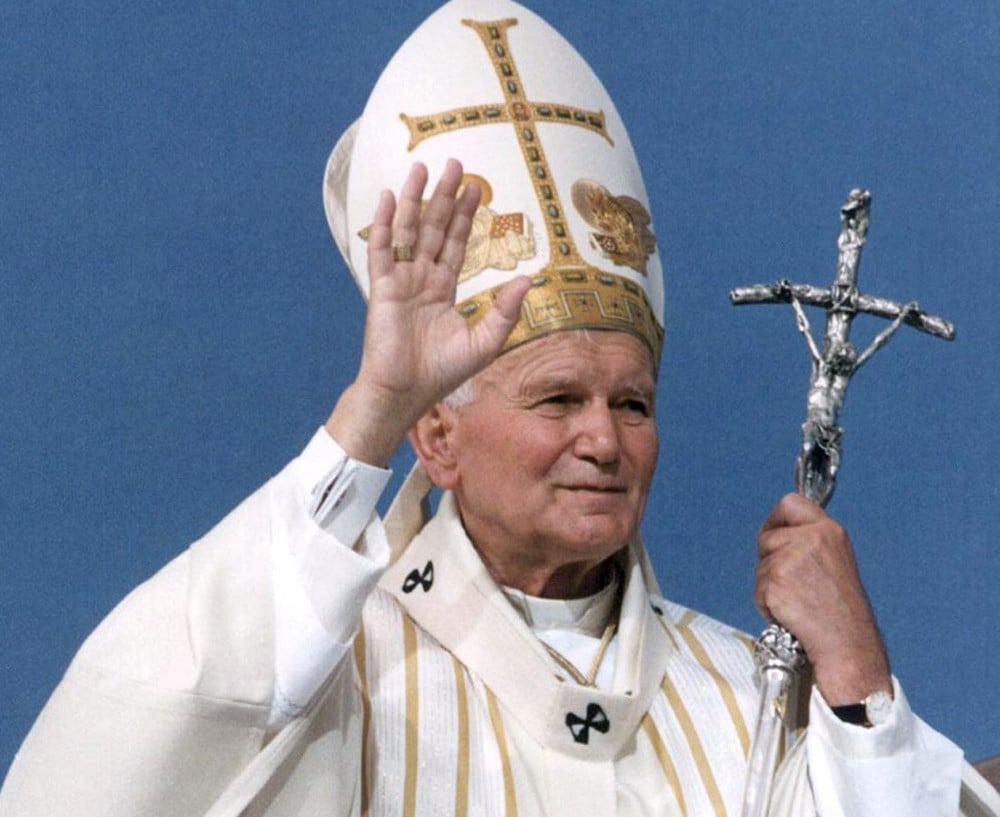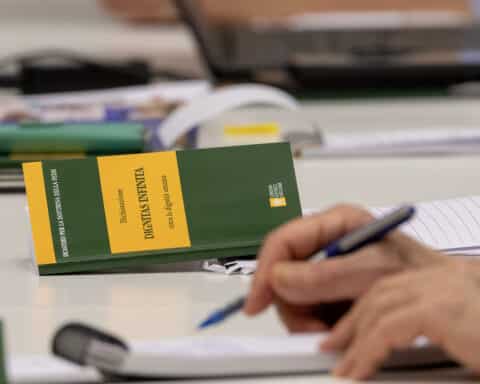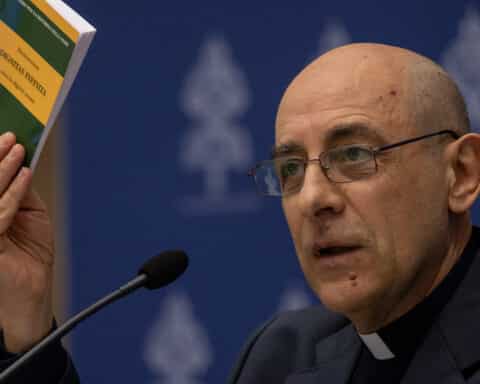You are loved. That is the splendor of truth. God, your creator, cherishes you, wants you and loves you simply for being who you are. You cannot earn or lose this love. It is a gift from God, and without it, all life would cease to be. “For if man exists it is because God has created him through love, and through love continues to hold him in existence. He cannot live fully according to truth unless he freely acknowledges that love and entrusts himself to his creator” (Gaudium Et Spes, No. 19). Yet, at the same time, a person can accept or reject God’s love, which is the same thing as accepting or rejecting God, “for God is love” (1 Jn 4:8).
But given this beautiful gift, why would anyone turn away from God? Pope St. John Paul II addresses this question in the encyclical Veritatis Splendor (“The Splendor of Truth”), dated Aug. 6, 1993, and he does so as part of a profound meditation on the Church’s moral teaching, which is based in truth, the source of which is God and revealed perfectly by Jesus. The pope demonstrates that “the only response [to God’s love] fully capable of satisfying the desire of the human heart” is to love God in return (No. 7). This “response of love” (No. 10) on the part of the human person is manifested in the moral life — to obey God and to please him in all things.
Context
Pope John Paul II was thinking about writing an encyclical on the Church’s moral teaching at least as far back as 1987 when he signaled his intention in the apostolic letter Spiritus Domini. In the letter, he lamented the loss of recognition in “the essential bond of Truth-God-Liberty” by many people in contemporary culture, which results in uncertainty about the meaning of life on the part of many men and women. He stated that he would respond soon.
Six years later, the pope released Veritatis Splendor, and he almost apologizes for the delay: “If this Encyclical, so long awaited, is being published only now, one of the reasons is that it seemed fitting for it to be preceded by the Catechism of the Catholic Church” (No. 5). The Catechism offers the reader “a complete and systematic exposition of Christian moral teaching” and “presents the moral life of believers in its fundamental elements” (No. 5). With the Catechism as backup, the encyclical focuses on the intimate connection among God, truth, and human freedom, which provides a sure foundation for the moral life.
Content
Veritatis Splendor contains a well-reasoned argument, using biblical exegesis and moral theology, to counteract what Pope John Paul II calls a “crisis of truth,” which has resulted in “a radically subjectivistic conception of moral judgment (No. 32). Some people, even some Christian theologians, deny a universal truth that applies to all people at all times (cf. No. 32). They say that each person must be free to use his mind to determine the meaning of his behavior (cf. No. 47). Such a mindset leads to many errors. It also accords the individual conscience “the status of a supreme tribunal of moral judgment which hands down categorical and infallible decisions about good and evil” (No. 32). The denial and its attendant errors sabotage the Church’s moral teaching and ignore God’s sovereignty.

The pope’s answer to the crisis of truth is Jesus, who shows us the way to live authentically as a human being and who embodies the truth that sets us free. Indeed, Jesus witnesses by his life how truth, God and freedom are inseparable. Pope St. John Paul II uses Jesus’ encounter with the rich young man (cf. Mt 19:16-30) to demonstrate how the human person can practice the moral life and come to eternal life with God.
Jesus’ answer to the young man focuses on God as the good, the loving Father who created man and woman and created them with a natural orientation to the fulfillment he intends for them. God placed the natural law within the heart of man and woman so they could understand the good to be done and the evil to be avoided (cf. No. 12). Even when human beings sinned, they did not lose this capacity to recognize right from wrong, but they did need God’s grace to be freed from sin and death, and so regain communion with God.
Jesus mentions two sources of grace: obedience to God’s commandments and discipleship in Christ. Obeying the commandments has many good effects: it gives glory to God, safeguards the dignity of the human person by training him in right conduct, it honors the relationships between people, and it moves one toward freedom (cf. No. 13). However, if a person wants to achieve perfection (i.e., communion with God), he must become Jesus’ disciple.
Jesus tells the rich young man, “Follow me.” The ability to follow Jesus is made possible by the Holy Spirit through the Church. Jesus sends his Spirit to form the Church after he fulfills — by his death and resurrection — the Father’s plan of salvation. The cross is “the sign of his indivisible love for the Father and for humanity” (No. 14).
The person who acknowledges and accepts God’s love accepts Jesus’ invitation and, like Jesus, loves God. Indeed, the person moves beyond obedience toward loftier challenges after the pattern of Christ. “Thus the commandment ‘you shall not murder’ becomes a call to an attentive love which protects and promotes the life of one’s neighbor” (No. 15). Having followed Jesus in the way of love, the disciple follows the Master to eternal life as well.
Pope John Paul II might have ended his defense of the truth and the Church’s moral teaching with the example of Jesus taken from Scripture. However, conscious of the errors advanced in some schools of thought, the pope also appeals to the moral sciences as well.
The pope writes that contemporary culture has a heightened sense of human dignity and values the freedom of individuals to make choices. These are good developments (cf. No. 31). Yet some people go too far and make freedom an absolute, and it becomes the source of values in place of God. To avoid this error, a person needs to exercise freedom in a way that corresponds to “the truth about man as a creature and the image of God” (No. 31). Genuine freedom seeks the truth and adheres to it once it is known (cf. No. 34). And truth cannot be known without knowing God and his law. “God, who alone is good, knows perfectly what is good for man, and by virtue of his very love proposes this good to man in the commandments” (No. 35).
Call

Veritatis Splendor, as an authentic teaching of the Church, seeks to help all people to live according to the truth, which comes from God, so that all may be truly free. “The Crucified Christ reveals the authentic meaning of freedom, he lives it fully, in the total gift of himself and calls his disciples to share in his freedom” (No. 85).
Jesus says to each person: “Follow me” (Mt 19:21). He does not mean an “outward imitation” (No. 21) but an interior conformity: receiving his body and blood in the Eucharist, digesting and practicing his words, serving others as he did, witnessing to the truth by one’s actions, and ultimately giving up one’s life — being a martyr — for love of God and neighbor.
John Paul II ends Veritatis Splendor with a prayer: that all who follow Jesus may receive the gift of his peace. It’s worth noting that the first words from the Risen Christ to his disciples were “Peace be with you” (Jn 20:19). Jesus would have used here the common Jewish greeting “Shalom,” which means “peace” not in the sense of the absence of conflict but in the sense of being in right order: May you have right order in your lives. This gets at the heart of the message of Veritatis Splendor, for we experience the peace of Christ when we honor the inseparable relationship among God, truth and freedom.
David Werning writes from Virginia.





